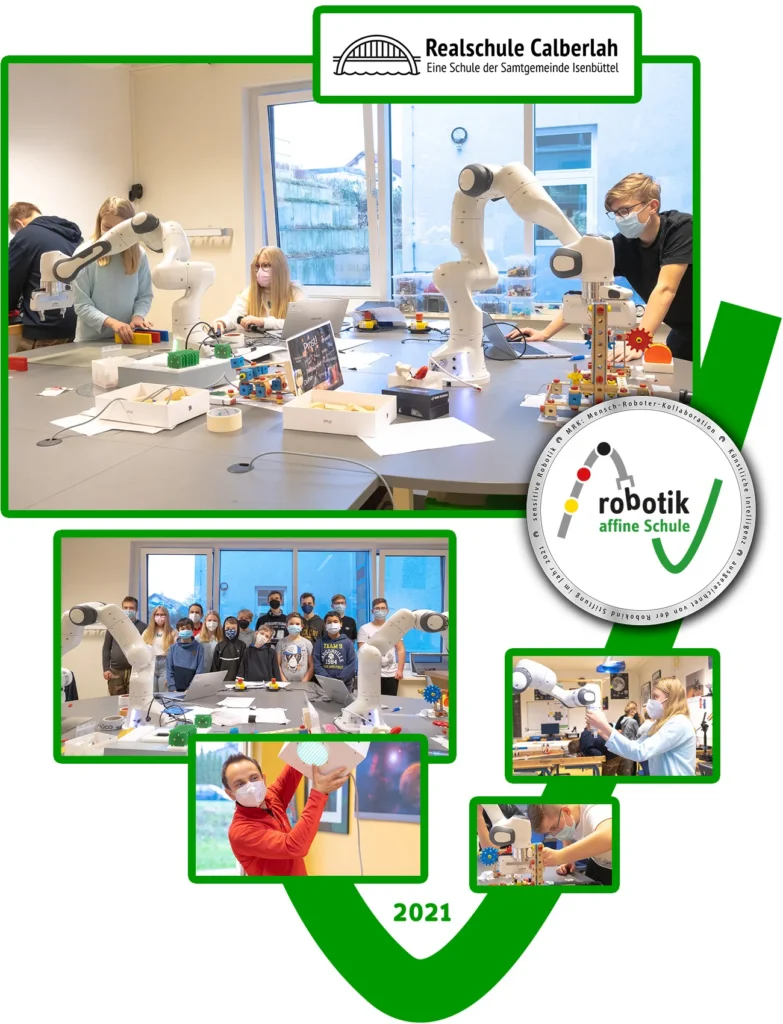
School with an affinity for robotics: Realschule Calberlah

“As robotics becomes more powerful and cheaper, […] it is important for us to prepare our students for a digitized world and human-robot collaboration. It’s also a hell of a lot of fun!”
Steffen Jauch, Teacher Calberlah
Why did you decide to teach robotics?
The Realschule Calberlah is located in the middle of the countryside, but in the middle of the automotive, mechanical engineering, aerospace industry centers Wolfsburg, Braunschweig and Gifhorn. The industrial areas of SG Isenbüttel are peppered with suppliers to these industries. For many companies, the use of (collaborative) robots is an important part of their economic trade. Due to the “short” distances and the good networking with these companies, we are aware of the existing requirements in this area for our students and educate them through creative projects and targeted career orientation measures. Due to the development towards Industry 4.0 and the associated growing spread of collaborative robot systems, job profiles are emerging that we do not yet know exactly today. Nevertheless, it is important for us to prepare our students for this professional world so that they can shape their future. And it’s a lot of fun!
In which subjects and grades is robotics taught?
Use of collaborative robots:
Robotics AG grade 5-10 SuS: 12 (6 W, 6 M) per school year.
Photo-AG/ Art Class 7-10 SuS: 25 per school year
BO-Coaching Class 8 – 10 SuS: approx. 20 per school year WPK
Computer Science Class 8 – 10 SuS: 30 per school year Profile Technology Class 9 -10 SuS: 30 per school year Profile GUS
Class 10 Students: 15 per school year (Profile) Economy Class 10 Students: 12 per school year GSW
Class 8 SuS: 25 per school year (Industrialization)
Elementary school grade 4 SuS: approx. 24 per school year (MissionX)
Presentation of deployment scenarios
The work with robot arms in the subjects Computer Science, (Profile ) Technology & the Robotics AG results directly from the curriculum content on control and regulation. The assistance of robots plays an increasing role in care, which is why it is being integrated into the Health & Social Care profile with a short learning unit. In the subject (profile) economics a learning unit on cost/benefit/performance calculation of MRK is part , to evaluate robotics from this perspective. In the GSW subjects in grade 8 the analysis of the importance of robots for the further development of manufacturing and professions (Industry 4.0) takes place in the context or as a contemporary reference to the industrialization in the 19th century. In the career orientation coaching, the robots are “means to an end” to train teamwork skills. In the photo club and in art lessons, the robot systems support creative media and film work. The elementary school students “capture” space transporters with the robot arm in the MissionX AG.
We are multipliers because…
In the MINT network of the NiedersachsenMetal l Foundation, there is close cooperation with the more than 20 participating schools and some vocational schools. In addition, the neighboring elementary schools are close cooperation partners. We share our training materials, teaching ideas and self-developed robotics teaching aids , such as the spring leg, with all other schools. We also open our robotics lab to other schools and, during the vacations, to citizens, young people and trainees from the industrial companies in the joint municipality. With the latter, we are working on the joint idea of a three-day voluntary “training module MRK”, which will be carried out practically at the Realschule Calberlah. The contents will be coordinated with the BBS II in Gifhorn in order to establish relevance to the training professions and contents. We also cooperate closely with DLR_School_Lab in Braunschweig and the European Space Education Resource Office.
Contact
Realschule Calberlah
Schulstr. 3
38547 Calberlah
Phone: 05374 – 96 56 30
Website: http://www.rs-calberlah.de
Contact person Steffen Jauch: s.jauch@rscalberlah.de